February in the Grand Canyon
Learn all about what it means to visit Grand Canyon National Park in February
Updated: 10/24/22
January and February are the two quietest months in Grand Canyon National Park. February is the calm before the Spring Break storm in many ways, as the winter temperatures and impending spring travel have many national park tourists grounded in their home cities. Which means it’s a great time to visit the Canyon! Winter storms are certainly a possibility, but also possible is a chance to have the Canyon mostly to yourself with perfect hiking temperatures.
Benefits of Visiting in February
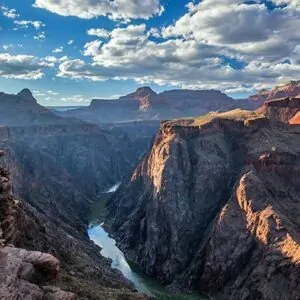 The biggest benefit of visiting the Grand Canyon in February is the lack of crowds. Summer is the busiest time of the year (despite the heat) and spring and fall are also quite busy in the park. Winter is quiet and peaceful in comparison and you are more likely to get the winter wonderland experience you are looking for. Instead of crowded roads, shuttle buses, and long lines, you are likely to find the park slow and hushed, perhaps with snowfall. Fewer than 15% of the park’s 6 million annual visitors come in the winter months. This also means that accommodations will be more readily available and less expensive in winter than they are in summer and the shoulder seasons.
The biggest benefit of visiting the Grand Canyon in February is the lack of crowds. Summer is the busiest time of the year (despite the heat) and spring and fall are also quite busy in the park. Winter is quiet and peaceful in comparison and you are more likely to get the winter wonderland experience you are looking for. Instead of crowded roads, shuttle buses, and long lines, you are likely to find the park slow and hushed, perhaps with snowfall. Fewer than 15% of the park’s 6 million annual visitors come in the winter months. This also means that accommodations will be more readily available and less expensive in winter than they are in summer and the shoulder seasons.
Another benefit of February is the cooler temperatures in the canyon. The park is notorious for extreme heat in the summer which makes hiking uncomfortable and sometimes dangerous, but in the winter the bottom of the canyon usually mellows out to comfortable hiking temperatures during the day and cooler nights. Unfortunately, this means that the rims will be chilly, often with snow. Make sure you’re prepared for the winter weather and the possibility of snow at the rims even if you are planning on hiking in the canyon as you will have to go through this alpine environment to descend into the desert environment of the canyon.
Permits for backcountry camping and hiking are also much easier to get in the winter than in the other seasons when there are more travelers and more who want to spend time in the backcountry. Even last-minute reservations at Phantom Ranch are commonly available. Photography opportunities and chances to see wildlife are abundant in winter. While much of the wildlife will be less active because of the cold, you might still see elk, big horn sheep, mule deer, and condors. The canyon itself is picture-worthy any time of year, but this majestic space dusted with light snow gives your photos a special element you won’t have later in the year.
Drawbacks of Visiting in February
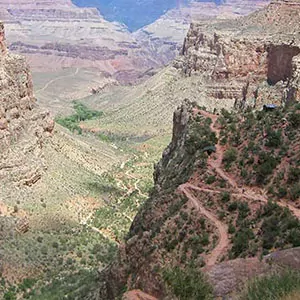
The biggest drawback of visiting the Grand Canyon in winter is the possibility of a winter storm and low temperatures. While the park is known for its heat and the desert climate within the canyon, guests often forget that the rims of the canyon are nearly 7,000 ft in elevation and are mountainous, alpine ecosystems. Because of this, visitors will need to be prepared for winter weather on the rims with more gear and clothing as if they were traveling to Yosemite in the winter. It is possible (unlike in other parks like Yosemite or Yellowstone) that you won’t use your winter gear if there hasn’t been a snowstorm in a few days, but it is also possible that you will encounter white-out conditions where you won’t be able to see the canyon at all.
Hypothermia is a real danger in the winter and taking a fall from snow or slipping on ice can cause serious injury. When a snowstorm does come in, it can effectively halt activities in the canyon as well as on the rims by closing roads, making hiking unpractical, and sometimes blocking your view of the canyon when visibility is limited to less than a hundred feet. Even if the weather is fair while you are there, the trails coming from the South Rim become treacherous and icy in the winter making hiking more dangerous and requiring extra gear, which can be expensive. It’s strongly recommended to use hiking crampons and trekking poles if you hike in February. Not only will the days be colder but they will also be shorter, providing you fewer daylight hours where the temperature is nice enough for exploring.
Another major drawback to February is that the North Rim is closed and the South Rim is your only option. This leaves much of the park inaccessible except for winter backpacking. While the South Rim is gorgeous and is the section of the park where most visitors spend their time, some feel as though they have missed out if they don’t have an opportunity to see the remote beauty of the North Rim. And while wildlife is still out in the winter, you won’t get the chance to see any of the park’s signature reptiles or amphibians which are in hibernation for the winter.
Things to Do in February
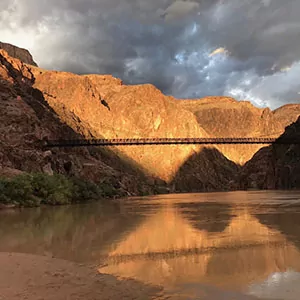
There are plenty of great things to do in the Canyon in January; in fact, most of the activities available at any other time of year are yours to choose from. Certainly, a hike on the South Kaibab or Bright Angel Trail is very much worth doing, but be sure to have hiking crampons for the icy trails (it’s not particularly advisable to hike Grandview, New Hance, or Tanner Trails in winter unless you’re with a guide company or are experienced.) Experienced hikers can also take a trip to the closed North Rim of the canyon by backpacking from the South Rim. While not for the inexperienced, this rim-to-rim-to-rim-to-rim hike allows visitors access to one of the most remote places in the United States and to have it almost completely to themselves. There are also opportunities for snowshoeing and cross-country skiing if there is snow on the ground or if you want to visit a nearby town or city to gain access to more snow. Because the snow doesn’t stick around for more than a few days in Grand Canyon in February, there are times when you might come to the park in winter and find no snow on the ground at all.
Besides hiking, sightseeing is probably the most popular option for something to do in the park. If the roads are clear of snow, you can drive much of the South Rim yourself, even on roads that usually prevent private vehicle access in the summer and require shuttle bus transportation. The most spectacular views are in the west between the visitor center and Hermit’s rest, but all of the rims provide unparalleled. Helicopter or airplane tours, van tours, and – if roads are clear – bicycle tours are great activities (read about Grand Canyon’s best tours for links to recommended companies.)
Checking out things like the Yavapai Geology Museum and the Kolb Studio is very much worth doing if the weather prevents you from being outside. The visitor center has a 22-minute film that is well worth watching, especially because it is from the comfort of a heated building. A trip on the Grand Canyon Railway that runs from Williams to the canyon is a great experience and it is sometimes accompanied by old western outlaws. On the west rim, the Grand Canyon skywalk (a bridge made entirely of glass suspended nearly 4000 feet above the canyon floor) or a visit to Eagle Point Native American village are both great options. Guests can also enjoy an all-American dinner at the historic El Tovar, which is a must-do activity in Grand Canyon, and reservations will be much easier to get in February than many months.
Wildlife viewing and photography are also great options in February. While many of the animals will be less active than in warmer temperatures, you will still have the opportunity to see some of the park’s signature creatures. If you have a sharp eye or a long lens, look for the California condor, the largest bird native to North America with a wing span of up to 9.5 ft. Photography of the canyon, especially if you can get a star-studded night sky behind it, is also spectacular.
Things to see in February
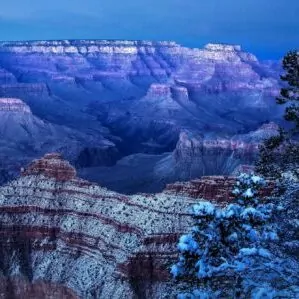 Grand Canyon National Park is well known for its opportunities for sightseeing. There are nearly as many sights to see in Grand Canyon as there are things to do, but what you want to see in the park really depends on what you are interested in. Below, we’ve compiled a short list of some of the must-see sights in the canyon in February, but make sure to do your own research to see what especially piques your interest in the park. There are opportunities to see old western and settler history, fossils and geological artifacts, and even art galleries and architecture, depending on what you are interested in.
Grand Canyon National Park is well known for its opportunities for sightseeing. There are nearly as many sights to see in Grand Canyon as there are things to do, but what you want to see in the park really depends on what you are interested in. Below, we’ve compiled a short list of some of the must-see sights in the canyon in February, but make sure to do your own research to see what especially piques your interest in the park. There are opportunities to see old western and settler history, fossils and geological artifacts, and even art galleries and architecture, depending on what you are interested in.
Hermit’s Rest/Scenic Drive: One of the roads that is closed to private vehicles in the summer, this drive is one of the most popular in the park and well deserves its reputation. Heading west along the South Rim, driving this road in a private vehicle allows you to take your time and really enjoy the overlooks without being rushed to catch your shuttle. At the end of the road, you’ll find a snack stand and gift shop in a building constructed to look like a miner’s cabin. In the early 1900s, visitors used this stand, called Hermit’s Rest, as the last spot of civilization before plunging into the canyon.
Plateau Point: This overlook which lies along the very famous Bright Angel Trial is known for having one of the best views of the Colorado River and the canyon in the park. Probably the most popular trail in the park, you will find Bright Angel Trail swarmed with visitors in the summer. But in winter, you will probably find it peaceful and quiet. South Kaibab Trail is less likely to have as much ice as Bright Angel Trail and has a good amount of shade (making it popular in the summer), Plateau Point is so spectacular that many think the longer trek is worth it for this overlook.
Hopi Point: One of the best overlooks along the Hermit’s Rest scenic drive, many claim that is the best spot for sunrise or sunset in the canyon. With sweeping panoramic views of the entire canyon and glimpses of the Colorado River, this viewpoint is great any time of year. It is especially good, however, in winter when you can drive to it yourself and not be swarmed with those that got off your shuttle bus as you will be in summer.
Desert View Watchtower: Inside the first village you encounter when entering from the eastern side, this watchtower is visited by few and climbed by fewer, but is well worth exploring. Built-in 1932 by architect Mary Colter, the tower seems to rise out of the canyon wall itself and uses the designs and inspiration of the Ancestral Puebloan people that inhabited the Colorado plateau. On the first level, there is a recreation of a Native American Kiva which often hosts cultural demonstrations while the upper floors provide fantastic views of the canyon.
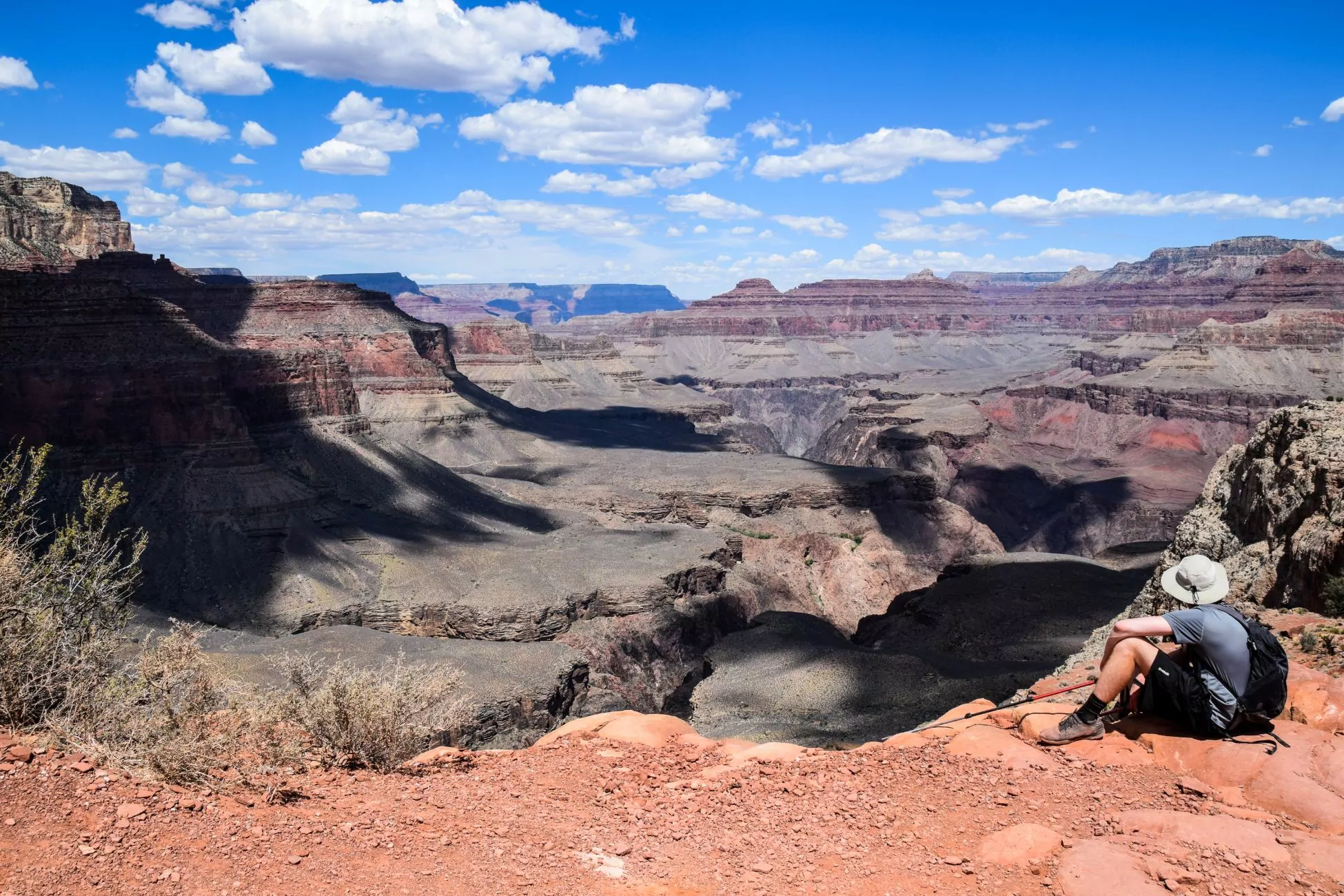
Hiking in February
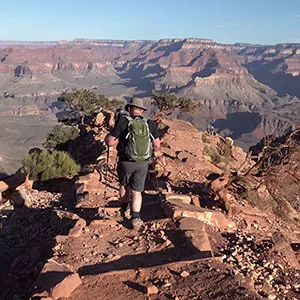
Hiking in Grand Canyon in February is spectacular with cooler temperatures that can be near perfect for the physical exertion of ascending back out of the Canyon and fantastic sights. We recommend sticking to Bright Angel Trail and South Kaibab Trail unless you’re going with a tour company or are an experienced hiker. Bright Angel Trail is the most popular and the most famous, but the trail has a good amount of shade (making it popular in summer) that can cause ice to build up especially for the first three miles from the rim. South Kaibab Trail, another famous and popular option, will probably have less ice as it receives more sun and heat even in the winter as it faces south. The first 1/4 of the trail, however, called the chimney, often maintains ice throughout the winter but ice is intermittent below this section.
Microspikes are highly recommended for hiking in February. Much like tire chains for your car, microspikes are small chains, rubber, and spikes that strap onto your hiking boots, giving you additional traction of ice and snow. Crampons are a more heavy-duty version of the same concept. It only takes a small section of ice to make you thankful that you have these. As most of the trails in Grand Canyon are steep, sliding down or slipping while trying to climb up the trails without additional traction on your feet is very likely. They are critical to have, even though they may seem to be expensive for a short trip. If you book a guided tour, they will be included along with trekking poles.
Early mornings can be very chilly at the South Rim and the temperature drops quickly after dark, so best to make sure your hike can be finished before nightfall as you will not want to be out in the elements after the sun has gone down. The ice on the trails often melts slightly during the day, creating a thin layer of water on the ice which makes it more slippery. Any rain during the day will also freeze overnight when the temperature drops back below freezing.
Hypothermia is a real danger in the Grand Canyon in the winter and it is important to recognize the signs of this condition and to know what to do if you or one of your group experiences it. It does not have to be below freezing for you to experience hypothermia as the body can become chilled from being overexposed to wind or rain even when the temperature is above 40 degrees. Because hypothermia often causes you to act recklessly and carelessly, it is important to hike in groups and make sure everyone knows to look for the signs as it can be difficult to recognize in yourself. Look for the symptoms of the “umbles”– grumbling, stumbling, mumbling, and fumbling. You can prevent these conditions by putting on your warm layers before you start shivering and breaking out your rain/snow gear before you get wet.
Make sure you are drinking plenty of water on your hike even though it is cold and that you carry it in an insulated container so that it does not freeze. The National Park’s Service also recommends eating salty snacks on your hike after an increase in deaths in the park due to water poisoning— a life-threatening condition caused by an imbalance of sodium in the body which causes cells to swell with water.
BACKPACKING IN February
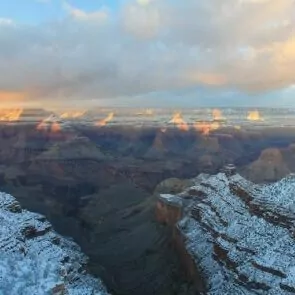 Despite it being winter, Grand Canyon National Park still has backpacking options available in February. While the rims will be very cold and will likely have snow, the canyon floor with have more moderate temperatures with comfortable days and cool nights that are perfect for backpacking. Of course, winter gear is a necessity to get down the canyon, but the weather inside is a blessed respite.
Despite it being winter, Grand Canyon National Park still has backpacking options available in February. While the rims will be very cold and will likely have snow, the canyon floor with have more moderate temperatures with comfortable days and cool nights that are perfect for backpacking. Of course, winter gear is a necessity to get down the canyon, but the weather inside is a blessed respite.
If you’ve never backpacked in the Grand Canyon before or if you’ve never camped in winter, consider going with a guiding company as backpacking comes with additional dangers and risks that day hiking does not. Depending on which trail you decide to take, you may need to use snowshoes or cross-country skis to get around on the snow, but this is more likely if you are staying on the rims and not descending into the canyon. For just a short one or two-night trip, you can hike down Bright Angel Trail and spend the night at Bright Angel Campground. You can explore the canyon around Garden Creek or Havasupai Garden before hiking back up to the South Rim via the Bright Angel Trail or South Kaibab Trail. There are many options within the canyon if you are looking for a longer trip such as the western trail along Hermit Loop which has stunning sites, great history, and spectacular fossils.
Many backpackers want to do a Rim-to-Rim-to-Rim backpacking trip in the Grand Canyon. This means hiking from the South Rim to the North Rim and back to the South Rim within a few days. You can do this trek in winter, despite the snow as the temperatures inside the canyon will be much more bearable than in summer or even in the shoulder seasons. The trail is very strenuous and should not be attempted by those who lack experience as the elevation is steep and the difference in weather from the canyon to the rim can be drastic. The North Rim is very remote and closed to cars during the winter so you must come back the way you came and cannot bail out halfway through.
Both rims come with all the risks of camping in the winter: whipping winds, freezing temperatures, and wild snow storms that may drop many feet of snow. Test out your winter gear before you rely on it in the backcountry and make sure to read the section about the dangers that come with day hiking as all of these are amplified when backpacking. Backpacking in Grand Canyon in January can very rewarding experience with solitude like a few other places, so assemble your winter gear and get ready to head out on an adventure.
Weather in February
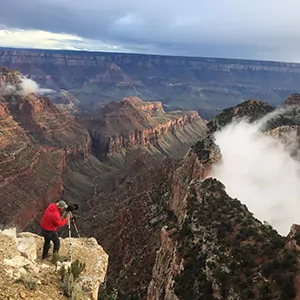
The Grand Canyon is a large park and due to the nature of the canyon landscape, the weather varies greatly between the rims of the canyon and inside the gorge itself. The average high at the South Rim in February is 48 degrees Fahrenheit, and the average low is 18 degrees Fahrenheit (high of 9 degrees Celsius, low -8 degrees Celsius.) However, these temperatures are much warmer inside the Canyon (by 10-20 degrees, feeling even warmer in the sun.) The average number of days of rain/snow in February is 5. At Phantom Ranch at the bottom of the Canyon, the average high temperature in February is 64 degrees Fahrenheit, and the low of 42 degrees Fahrenheit (18H/6L degrees Celsius.) Visitors should keep in mind that these numbers are just averages and that the park can be much warmer or colder than these. The possibility of both rain and snow can make packing for your trip a hassle. Rainfall during the warmer daytime hours is likely to freeze overnight and may cause treacherous conditions on roads and trails. Snowfall, although it usually melts within a few days can also close roads and trails, so you may want to bring a good book or some board games to keep yourself busy if the weather literally prevents you from being outside.
Mornings are typically chilly and temperatures drop sharply after sundown so make sure that your activities for the day will finish before the early onset of winter nights. Make sure to watch out for thin layers of water on top of ice that has melted during the day as this can make ice extra slippery. Crampons or Microspikes are a must for this time of year as slipping on ice while hiking along a cliff can quickly turn into a disaster.
Hypothermia is a real threat in the park in winter, even if the temperatures are not below freezing, so make sure to break out your warm layers before you start shivering and put on your rain gear before you get wet. It is best for everyone in the group to know how to recognize the signs of hypothermia and to commit to turning around if someone exhibits the symptoms. The best way to avoid hypothermia is to dress in layers that you can put on/take off as the temperature around you changes. If you only bring your ski jacket you are going to be too warm most of the time but too cold if you take it off. Always check the forecast and current conditions before setting out on a hike and check with a ranger at the visitor center for specific information about different trails and roads.
WILDLIFE IN February
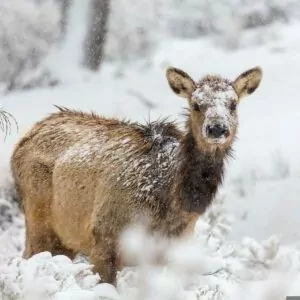 Wildlife in the Grand Canyon in the winter months slows down compared to summer and the shoulder seasons. The reptiles and amphibians are in hibernation for the duration of the colder seasons, so you won’t be able to see any of the park’s signature snakes or lizards. There are, however, many animals that remain out in the winter. The park’s ungulates, mainly mule deer and elk, can often be seen foraging on the ponderosa pines on the rims, and birds of prey such as eagles and falcons can be seen soaring on the updrafts from the warmer air in the canyon rising up the rims.
Wildlife in the Grand Canyon in the winter months slows down compared to summer and the shoulder seasons. The reptiles and amphibians are in hibernation for the duration of the colder seasons, so you won’t be able to see any of the park’s signature snakes or lizards. There are, however, many animals that remain out in the winter. The park’s ungulates, mainly mule deer and elk, can often be seen foraging on the ponderosa pines on the rims, and birds of prey such as eagles and falcons can be seen soaring on the updrafts from the warmer air in the canyon rising up the rims.
Perhaps the most famous of the Grand Canyon’s wildlife is the California condor, the largest bird native to North America. With a wing span that can reach up to 9.5 ft, this ancient bird was brought back from the brink of extinction through captive breeding programs and is a great success story of conservation. These birds are often confused with turkey vultures while in flight, but vultures are much smaller and appear to “wobble” when flying while condors fly much smoother. Sometimes considered the land equivalent of the sea-going albatross, the condor rarely roosts in the same place for more than two nights if it doesn’t have a nest and can travel many miles a day.
Another of Arizona’s distinct wildlife residents is the javelina, also known as the collared peccary. While they go by many common names and look like pigs, javelinas are in a different family than pigs and are known for their tough eating habits which sometimes even include cactus. Many other species of wildlife inhabit the park but are rarely seen by visitors. Big horn sheep blend in well with the rocks they inhabit so aren’t often seen. Mountain lions, bobcats, and coyotes are some of the predators that inhabit the canyon, but are typically shy and avoid people. The snow can be an advantage to those looking for wildlife as it maintains tracks better than dirt. While many of these species are less active because of the cold, patient visitors can still catch a glimpse of them and it will be well worth the wait.
RECOMMENDED WILDLAND TRIPS
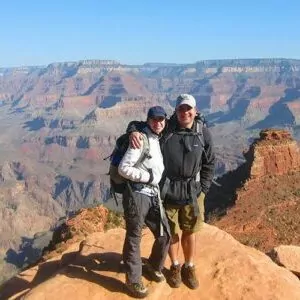 Planning a trip to Grand Canyon in winter can be overwhelming as you try to keep up with current conditions, closures, forecasts, and which trails and activities will be safe. But there is a way to bypass all the headache that goes into planning your own trip: booking a trip with a guiding company. Our expert guides at Wildland Trekking will make sure you aren’t missing any crucial safety information and that you’ll have a great time exploring the area. We have a variety of trip styles from backpacking and mule-assisted treks to basecamp trips and inn-based tours. Feel free to explore all the trips we offer in Grand Canyon, but here are a few we especially recommend for February.
Planning a trip to Grand Canyon in winter can be overwhelming as you try to keep up with current conditions, closures, forecasts, and which trails and activities will be safe. But there is a way to bypass all the headache that goes into planning your own trip: booking a trip with a guiding company. Our expert guides at Wildland Trekking will make sure you aren’t missing any crucial safety information and that you’ll have a great time exploring the area. We have a variety of trip styles from backpacking and mule-assisted treks to basecamp trips and inn-based tours. Feel free to explore all the trips we offer in Grand Canyon, but here are a few we especially recommend for February.
Best of Grand Canyon: Designed for those looking to explore the wonders of the Grand Canyon with the amenities and comforts of a hotel in the evening, this inn-based tour is not to be missed in February when the park is quiet and hushed with snow. With day hikes each day, visits to notable museums and visitor centers, and a dinner at the historic El Tovar Hotel, this trip is the perfect blend of rustic and comfortable. An all-inclusive tour, this three-day trip includes local transportation, meals, lodging, and of the gear you will need for this adventure.
Phantom Ranch Tour: While this is also an inn-based tour, it is much nearer to a backpacking trip as it involves carrying (or letting a mule carry) your belongings into the canyon and spending a night at the primitive inn at the bottom of the canyon. With 2 or 3-day options, this trip will allow visitors to explore the bottom of the canyon with the comfort of real beds but the challenge of hiking the canyon. With reservations much easier to get and the weather much nicer in the winter, this trip is great in February.
Winter Rim to Rim to Rim: If you want to hike rim to rim to rim, but aren’t sure if you have the equipment or expertise to do so on your own, this is the trip for you. Experience true solitude on the remote North Rim of the Grand Canyon while having the peace of mind of going with a guide who has done it all before. With Native American ruins, waterfalls, box canyons, and the potential for wildlife, you are sure to enjoy this all-inclusive backpacking trip.
Join a Guided Hiking Adventure
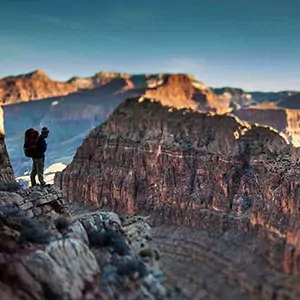 Grand Canyon National Park is home to some of the most unique and spectacular hiking vacations in the world. Wildland Trekking offers trips with stunning views, geologic history, and incredible hiking and backpacking for visitors who want to have an active, adventurous experience.
Grand Canyon National Park is home to some of the most unique and spectacular hiking vacations in the world. Wildland Trekking offers trips with stunning views, geologic history, and incredible hiking and backpacking for visitors who want to have an active, adventurous experience.
Guided Grand Canyon treks include permits, local transportation (excluded on certain tours), meals, gear, risk management systems, and professional guides, allowing guests to make the most of their visit to the Canyon, focus 100% on enjoying their experience, and do it all with an increased level of safety and comfort.
GRAND CANYON ADVENTURE TOURS
- GUIDED BACKPACKING ADVENTURES: these are for people interested in an authentic adventure deep in the Canyon’s wilderness.
- HORSE-ASSISTED TRIP: on this trip to the bottom of the Canyon, guests hike with light day packs and camp near the Colorado River.
- PHANTOM RANCH TOURS: this tour (limited dates) goes to the bottom of the Canyon where we sleep 1 or 2 nights in the Phantom Ranch Lodge 5 minutes from the Colorado River. Showers, A/C, heat…etc.
- ALL-INCLUSIVE HIKING PACKAGES: inn-based and camping-based hiking packages provide all-around hiking experiences of the Grand Canyon.
- DAY HIKE TOURS: maximize your day at Grand Canyon on a fully guided, award-winning hiking tour on one of the Park’s best trails.





